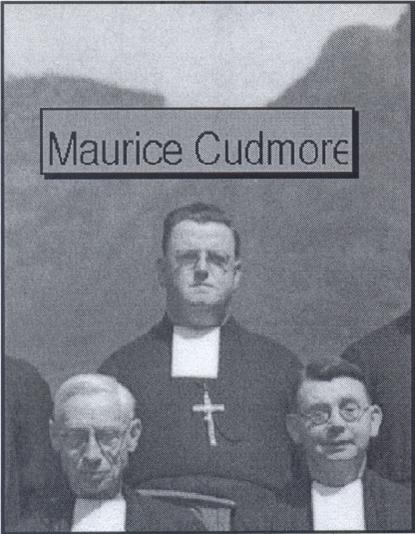Brother Maurice Cudmore
Vincent” the son of Patrick Cudmore and Alice Quirk, was born in Grahamstown on 1 December 1915.
Grahamstown-The capital of the Eastem Cape Province, Grahamstown was founded in 1812 by Colonel John Graham. The intention was to establish a military outpost on the troubled frontier in order to effect pacification after the FourthFrontierWar.
A line of blockhouses was built to guard from the heights the prodigious valley of the Fish River which formed the frontier line -the line of collision -between European settlers expanding from the south and African tribal groups migrating from the north. The choice of the site of Grahamstown was admirable. It was made by Colonel Graham while he was resting in the shade of an acacia tree which grew on a position today marked by a memorial on an island in High Street opposite Fishers Building. The river known to the Xhosas as the Qoyi(rushing) had its headwaters nearby in a number of streams bubbling to life on the slopes of the overlooking heights. In the valley below, close to the tree under which Graham rested, they united to form the river whose name was corrupted by Europeans into the familiar Kowie of today.
He attended our school in Port Elizabeth before going to the Juniorate in Belgium and from there to the Bairo Novitiate, both in 1931. He made his First Profession on July 31, 1933 and returned immediately to South Africa. Whilst at the Scholasticate in Prestbury he did his Matric, passing First Class, then attended the Teacher Training College before taking up his first appointment at Koch St. Thereafter he taught in Uitenhage, Durban, Rondebosch (where he is shown here), Observatory. Pietermaritzburg, Inanda and Walmer at various times. For three years, 1953-5 he led St Henry’s in Durban, and at other times he taught or was bursar.
 The above short resume does no credit to the man for: Brother Maurice was an exceptionally gifted man. One wonders what career he would have followed if he had not become a Religious. It is certain that he had the natural ability to excel in anyone ofa dozen professions and we can indeed be grateful that his many talents were generously placed at the disposal of the Marist Brothers and the Marist schools in South Africa. Apart from his fine work in the classroom/ he found time to do an extraordinary amount of manual work/ and every house and school in the Province bears testimony to his Champagnat-like spirit of work.
The above short resume does no credit to the man for: Brother Maurice was an exceptionally gifted man. One wonders what career he would have followed if he had not become a Religious. It is certain that he had the natural ability to excel in anyone ofa dozen professions and we can indeed be grateful that his many talents were generously placed at the disposal of the Marist Brothers and the Marist schools in South Africa. Apart from his fine work in the classroom/ he found time to do an extraordinary amount of manual work/ and every house and school in the Province bears testimony to his Champagnat-like spirit of work.
His skilled craftsmanship and practical good judgement were evident in every job he did whether it involved making a small table or constructing a stand to seat a thousand people. The finished work/ which was usually completed sooner than anyone expected/ was always attractive/ durable and as he used to
term it “schoolboy proof’ As one Brother put it the morning after Brother Maurice’s death: “By this time Maurice will be in heaven and will probably have fixed a few rickety celestial chairs/ or put a few drops of oil on the Pearly Gates or perhaps will be busy making the path leading up to them smoother and wider. ” It was significant that a man who had made so many Rosary beads should die on the first day of the months dedicated to Our Lady of the Rosary. (Nothing is said in this Obituary of his calligraphy – both for presentation Scrollsor in his own private notebooks of poetry, or of his singing voice – and his astounding memory for the lyrics of many an old song).
It could be justifiably claimed that Maurice had more than his share of crosses to carry. The work that he did is all the more remarkable when one considers that for many years he suffered from a mild form of diabetes/a not-so-mild form of angina (he mentions seeing a heart specialist in 1952) and from a hip injury sustained in a car accident. He never had the privilege of teaching English/ a subject of which he had such a wide knowledge and keen appreciation (one of his standard jokes – ‘I don’t know that word therefore it does not exist’) ; he had instead to teach Afrikaans and other subjects where’ teachers were less plentiful. Nowadays/ when we hear so much about the need for self-fu/filment/ we surely have something to learn from the life of a man who appreciated that he had opted for a vocation which would not satisfy many of his natural aspirations or give expression to many of his talents/ but which involved instead a great deal of self-giving.

When in retirement in Durban he appeared to be recovering from a serious operation – for cancer of the bowel as he calmly announced in his diary- he had to be re-admitted to hospital on 28 September. The angina attacks became more frequent and it was a heart attack that finally carried him off- a blessing in a way for the cancer had been diagnosed as terminal.
Brother is buried in the Marist plot in Stellawood cemetery, Durban.